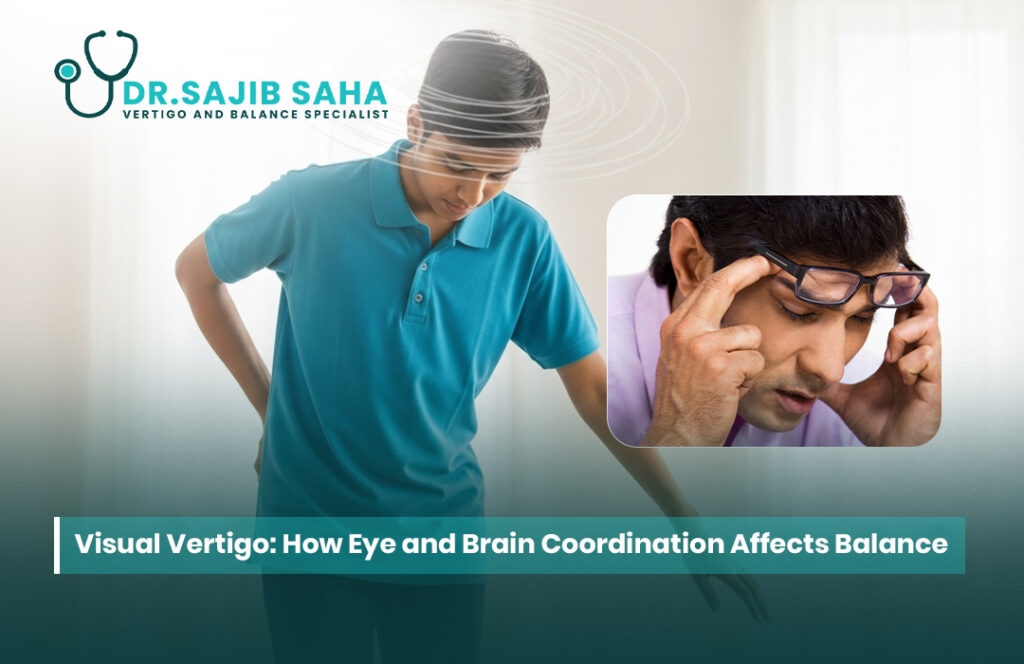Do you feel dizzy when scrolling your phone, watching fast-moving visuals, or walking in a supermarket?
You may be experiencing visual vertigo, a condition that occurs when your eyes, brain, and inner ear fail to coordinate properly.
At Dr. Sajib Saha’s Balance Disorder Clinic in Dhaka, patients frequently describe feeling “off balance” in visually complex environments. Understanding how your vision and brain work together is the key to overcoming this form of vertigo.
What Is Visual Vertigo?
Visual vertigo—also called visual motion sensitivity—is a form of dizziness that results from a conflict between visual and vestibular signals.
Your eyes detect motion, while your inner ear (vestibular system) senses body position and balance. When these two systems send mismatched information to the brain, confusion occurs, leading to dizziness or disorientation.
Common Symptoms of Visual Vertigo
-
Sensation of spinning or swaying
-
Dizziness triggered by visual motion
-
Difficulty focusing on moving objects
-
Headache or eye strain after screen time
-
Nausea or imbalance in crowded places
-
Fatigue or anxiety after prolonged visual activity
These symptoms often worsen with exposure to bright lights, screens, or complex visual patterns.
What Causes Visual Vertigo?
Visual vertigo doesn’t happen suddenly — it usually develops after an imbalance in the vestibular system.
The following conditions are often linked to visual vertigo:
-
Benign Paroxysmal Positional Vertigo (BPPV)
-
Vestibular Neuritis or Labyrinthitis (inner ear inflammation)
-
Meniere’s Disease (fluid imbalance in the inner ear)
-
Vestibular Migraine
-
Concussion or Head Trauma
-
Anxiety and Motion Sensitivity Disorders
When the inner ear is impaired, the brain starts depending more on visual input for balance. This overreliance on sight makes the brain hypersensitive to visual movement, leading to dizziness even from small visual triggers.
Everyday Triggers of Visual Vertigo
Patients at Dr. Sajib Saha’s Clinic often report dizziness in situations like:
-
Scrolling rapidly on a smartphone or computer
-
Watching high-speed videos or playing video games
-
Driving through tunnels or traffic
-
Walking in supermarkets or malls with patterned floors
-
Using virtual reality (VR) devices or 3D visuals
-
Sitting in moving vehicles and looking outside
If these situations make you feel dizzy or “motion sick,” you may be experiencing visual vertigo.
How the Eyes and Brain Coordinate Balance
Your balance system is controlled by three key parts:
-
Eyes (Visual system) – Help you perceive motion and orientation
-
Inner ear (Vestibular system) – Detects head movement and spatial balance
-
Proprioceptors (Muscles & joints) – Sense your body’s position
When any of these systems send conflicting signals, your brain struggles to interpret them correctly — causing dizziness, confusion, or motion sensitivity.
That’s why proper coordination between the eyes and brain is essential for steady balance.
Diagnosis of Visual Vertigo
At Dr. Sajib Saha’s Balance Disorder Clinic, diagnosis includes:
-
Detailed Patient History – Identifying visual and motion triggers
-
Vestibular Function Tests – Assessing inner ear performance
-
Oculomotor (Eye Movement) Assessment – Detecting abnormal eye tracking
-
Balance and Posturography Tests – Measuring how your body maintains stability
-
Screening for Migraine and Neurological Disorders
This comprehensive approach helps distinguish visual vertigo from other causes of dizziness such as BPPV or cervical vertigo.
Effective Treatment Options for Visual Vertigo
Visual vertigo can be successfully managed with the right combination of therapies.
Dr. Sajib Saha uses evidence-based techniques that focus on retraining the brain to process visual and balance signals correctly.
1. Vestibular Rehabilitation Therapy (VRT)
A customized set of exercises designed to improve balance, eye control, and coordination between sensory systems.
2. Visual Desensitization Exercises
Gradual exposure to visual motion patterns helps reduce sensitivity and build tolerance over time.
3. Gaze Stabilization & Eye Tracking Therapy
Exercises that strengthen the link between eye movement and head control, reducing dizziness during motion.
4. Treating Underlying Vestibular Disorders
If vertigo is caused by BPPV, Meniere’s disease, or vestibular neuritis, targeted treatment of those conditions comes first.
5. Lifestyle & Home Management Tips
-
Avoid rapid scrolling or flashing visuals
-
Maintain regular sleep and hydration
-
Adjust screen brightness and viewing distance
-
Practice breathing or relaxation exercises to reduce anxiety
With consistent therapy, most patients experience significant improvement within weeks.
When to See a Vertigo Specialist in Dhaka
If you feel dizzy in visually stimulating environments or have unexplained imbalance, it’s important to consult a balance disorder specialist early.
Ignoring symptoms can worsen visual dependency and delay recovery.
Dr. Sajib Saha, one of Dhaka’s leading ENT and vestibular specialists, provides comprehensive evaluation and therapy for vertigo, dizziness, and balance disorders at his clinic on Panthapath, Dhaka.
Frequently Asked Questions (FAQ)
1. Can visual vertigo be cured?
Yes. With proper vestibular rehabilitation and visual therapy, most patients recover fully or experience major symptom reduction.
2. Is visual vertigo the same as motion sickness?
They are similar but not identical. Motion sickness occurs during physical movement, while visual vertigo can happen even when you’re standing still.
3. How long does recovery take?
It depends on the severity and cause. Mild cases improve within a few weeks of therapy; chronic cases may take 2–3 months of consistent rehabilitation.
4. Can anxiety make visual vertigo worse?
Yes. Anxiety can amplify symptoms. Relaxation and mindfulness techniques can help alongside medical treatment.
5. Should I stop using digital screens?
Not necessarily — but limit long exposure, take frequent breaks, and use anti-glare settings to reduce strain.
Final Thoughts
Visual vertigo reminds us how delicate our eye-brain balance system really is.
When this coordination falters, even simple movements can feel overwhelming.
With early diagnosis, personalized vestibular therapy, and lifestyle adjustments, you can regain stability and live confidently again.
If you’re struggling with dizziness, imbalance, or motion sensitivity, book a consultation with Dr. Sajib Saha — a trusted balance disorder specialist in Dhaka — and take your first step toward recovery
